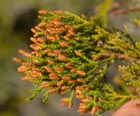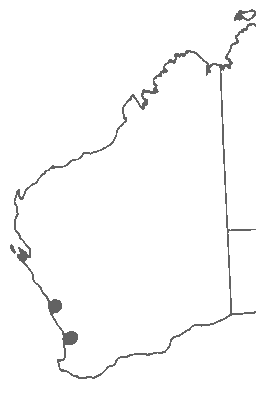
Plant in habitat, near Hill River, Western Australia (all photos same area) [©Rick Fencl, 2017.10.30].

Mature plant [©Rick Fencl, 2017.10.30].

Stem and maturing seed cone [©Rick Fencl, 2017.10.30].

Foliage and maturing pollen cones [©Rick Fencl, 2017.10.30].

Distribution of Callitris acuminata (Hill 1998). You can also create a highly detailed map, and access specimen data, using the "search" function at the Australia Virtual Herbarium.

Conservation Status

Callitris acuminata
(Parl). F. Mueller 1862
Common names
Moore cypress-pine (Silba 1986).
Taxonomic notes
Many authorities still name this taxon Actinostrobus arenarius, for so it was known from 1862 until (for me) 2020; see Callitris for discussion of why it is now placed in Callitris.
Syn: Actinostrobus acuminatus Parlatore 1862. Type: Between Moore and Murchison Rivers, Western Australia, 1863, J.Drummond 6, 225; holo: Fl. (Hill 1998).
Description
A prostate plant or a small broadly conical shrub to 3 m. tall. Plant spreads by underground stolons. Branchlets finely divided, twisted into long branchlets. Juvenile leaves light silvery-green, 8-15 mm. long, needle-like, persistent. Adult leaves scalelike, in whorls of 3, up to 10 mm. long, dark green. Male cones ovoid, on a peduncle 4 mm. long, 4-6 mm long, 2-3 mm diameter, with 20 acuminate scales with a dorsal crest. Female cones yellowish-brown to glaucous-brown, ovoid-conical, distinctly longer than broad, acute, 20-35 mm long, 15-25 mm diameter, often subtended at the base by juvenile leaves to 1 cm. long; the 6 scales acute, erect, spreading when open, distinctly hooked at tip. Seeds variable, dark brown, 9-12 mm. long, 9-13 mm. wide, wing 2-5 mm. wide, hilium 3-5 mm. long and white. Cotyledons 2, light green, 15-18 mm. long by 3-3.5 mm. wide, apex bluntly acute, stem to 2 mm. thick (Silba 1986, Hill 1998). See García Esteban et al. (2004) for a detailed characterization of the wood anatomy.
Distribution and Ecology
Western Australia: "Endemic from Eneabba south to the Perth district, south-western WA.; locally frequent in low shrubland on sandplain." Cited collections (presumably wild plants) include 0.8 km S of Coorow-Green Head road on Brand Highway, and 1 mile along McNamara Road (Hill 1998).
Zone 10 (cold hardiness limit between -1°C and +4.4°C) (Bannister and Neuner 2001).
Remarkable Specimens
No data as of 2023.03.03.
Ethnobotany
Reported as having a medicinal use for rheumatism (Silba 1986).
Observations
Remarks
The epithet presumably refers to the acuminate tips of the cone scales.
Citations
Parlatore, F. 1862. Index seminum in horto botanico regii musei florentini: 1862. Florence (p. 25).
See also
Blackall, W.E. and B.J. Grieve. 1954. How to Know W. Austral. Wildflowers. 1: 6 (Illustrations).
Farjon (2005) provides a detailed account, with illustrations (as Actinostrobus acuminatus).
Krussmann, G. 1985. Manual of Cultivated Conifers 2nd edition, 47, fig. 15 (Illustration).
Piggin, J., and J.J. Bruhl. 2010. Phylogeny reconstruction of Callitris Vent. (Cupressaceae)
and its allies leads to inclusion of Actinostrobus within Callitris. Australian Systematic Botany 23:69-93. Provides a good discussion of the type specimen and a photo of the isolectotype.





